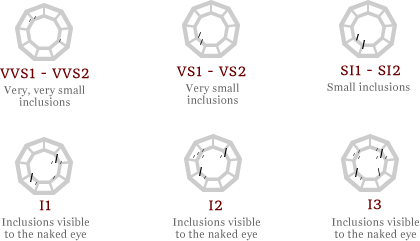We use cookies to improve your experience on our website. By continuing to browse this website, you accept the use of cookies. You can find out more in our Privacy Policy.
Cut, Color, Clarity & Carat Weight
When deciding to make a purchase, assessing the quality and value of the product is of the utmost importance. When buying a car, a house, or a television, we take into account all the features they have to offer, making sure that the product upholds high quality standards. Buying diamonds is no different, but how can we tell when a diamond is high quality?
In order to make a fully informed decision about your diamond, it is necessary to understand the Four C’s: Cut, Color, Clarity, and Carat Weight. The combination of these four characteristics is what makes your diamond unique, and gives it its value. Any difference in quality makes a difference in the price.
Cut
Many people confuse cut with diamond shape. Cut however pertains to the reflective facets of the diamond. Craftsmen cut the face of the diamond in a particular way in order to reflect the most amount of light back to the eye. Most diamonds are composed of 58 perfectly angled flat sides called facets. It is the perfect position of every facet that determines the brightness and beauty of the diamond. The better the cut of the diamond, the more luminous it will be.
How a Diamond Reflects Light:
When a diamond is well cut the light penetrates, reflects from facet to facet, and is then dispersed by the crown. As the light disperses, the top of the diamond appears to flash in a rainbow of colors. If the cut is too deep, some light escapes through the opposite side of the pavilion or bottom of the diamond. If the cut is too low, the light escapes through the pavilion before being reflected.

Color

The color of a diamond is graded on a scale, starting at colorless and ending with light yellow. A diamond receives a grade for its color, with D representing colorless, and scaling all the way down to Z, representing a light yellow color. The most coveted and expensive diamonds are colorless, as these diamonds reflect the brilliant colors of the rainbow at just a glance. Some diamonds display yellow to brown tones and are known as “Champagne” diamonds. Yet others come in rare colors such as red, blue, green, pink and amber and are referred to as “fancy” diamonds.
Clarity
All diamonds contain minuscule particles of diamond crystals and other minerals, and are part of what make a diamond unique. Considered to be “the fingerprints of nature,” these particles are often called inclusions, and a diamond will receive a grading based on the amount of inclusions it has. The less inclusions, the more rare and expensive the diamond will be. A diamond that is completely free of such small particles or inclusions is considered “flawless”. Because these inclusions are invisible to the naked eye, experts magnify diamonds 10x in order to give the diamond a clarity grade.

Carat Weight
Like all gemstones, the weight, and therefor the size, of the diamond is expressed in carats. A carat is divided into 100 points, so that a diamond of 25 points is described as a quarter of a carat or 0.25 carats. Size is the most obvious factor in determining the value of the diamond, but two diamonds of equal size can have very unequal prices depending on their quality, and diamonds of high quality can be found in all range of sizes.
Here are some examples that show the approximate size of diamonds of varying carat weights.

The Different Facets of a Diamond


